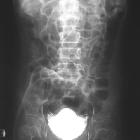bladder rupture































Urinary bladder rupture is usually seen in the context of significant trauma.
Pathology
Etiology
Bladder rupture can be categorized into five types depending on the location and extent of the rupture:
Bladder contusion
This is commonly seen but sometimes not classed as true rupture, since it involves an incomplete tear of the mucosa.
Subserosal bladder rupture
Also known as interstitial rupture, this is rare. It is caused by a tear in the serosal surface.
Intraperitoneal bladder rupture
Occurs in approximately ~15% (range 10-20%) of major bladder injuries, and typically is the result of a direct blow to the already distended bladder. Cystography demonstrates intraperitoneal contrast material around bowel loops, between mesenteric folds and in the paracolic gutters. Treatment is surgical repair.
Extraperitoneal bladder rupture
Extraperitoneal rupture is the most common type of bladder injury, accounting for ~85% (range 80-90%) of cases. It is usually the result of pelvic fractures or penetrating trauma. Cystography reveals a variable path of extravasated contrast material. Treatment is with an indwelling Foley catheter.
Combined bladder rupture
Simultaneous intraperitoneal and extraperitoneal injury. Cystography usually demonstrates extravasation patterns that are typical for both types of injury.
Radiographic features
Traditional investigation for suspected bladder rupture was carried out with fluoroscopic cystography . However, as this is time-consuming and cannot characterize other pelvic structures its use is being gradually superseded by CT cystography.
CT
CT cystography is performed by instilling water-soluble contrast into the bladder through a Foley catheter. It may be combined with standard CT to evaluate the upper tracts. An extraluminal position of a urinary catheter indicates bladder rupture, although, in an underfilled bladder, the tip of the catheter may falsely appear extraluminal.
Appearances vary with the site of injury:
- bladder contusion
- normal
- subserosal bladder rupture
- elliptical extravasation of contrast around the bladder
- intraperitoneal
- usually bladder dome rupture
- contrast in paracolic gutters and between loops of small bowel
- extraperitoneal
- usually at bladder base anterolaterally
- extraluminal contrast into perivesical space (simple)
- molar tooth sign
- extension of extraluminal contrast to the thigh, scrotum or perineum (complex)
- combined
- mixed features of intraperitoneal and extraperitoneal rupture
Treatment and prognosis
Intraperitoneal rupture requires surgical repair while extraperitoneal injuries are treated conservatively with a bladder catheter. The presence of other renal tract injuries involving the ureters or urethra may require separate intervention.
See also
Siehe auch:
- Blasenruptur intraperitoneal
- spontane Harnblasenruptur
- combined intraperitoneal and extraperitoneal bladder rupture
und weiter:

 Assoziationen und Differentialdiagnosen zu Blasenruptur:
Assoziationen und Differentialdiagnosen zu Blasenruptur: